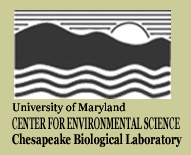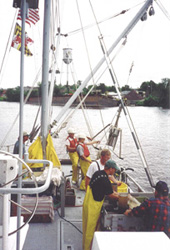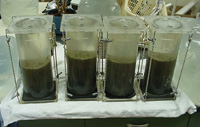Overview:
In the past decade, major factors influencing sediment-water fluxes have been identified, and include temperature, dissolved oxygen conditions, redox potential (Eh), macrofaunal characteristics, and organic loading to the sediment surface. To date, all of these factors, except organic matter loading rates, have been well examined. The importance of organic deposition has been recognized since the late 1960's, but relatively little research has been conducted to clarify this relationship. For several years we maintained a sediment trap in the deeper portion of the mesohaline Chesapeake Bay and made vertical deposition rate estimates on a weekly basis for 8-11 months of the year. Measurements of sediment-water nutrient exchanges were made on a monthly basis at this site during the same years. Deposition and flux data from stations were averaged for the spring period that encompassed the spring bloom and a three month period following the bloom period, respectively. One set of results is shown wherein we found a reasonably strong relationship between deposition rate of total chlorophyll from the spring bloom and summer period releases of ammonium and phosphorus from sediments. The conceptual model we have is that diatoms associated with the spring bloom in this estuary largely sink to the bottom without being grazed. Once on the bottom this labile organic matter does not decompose immediately because of relatively low temperatures. Once the water warms, decomposition is rapid and nutrient releases appear to be proportional to organic matter loading rates, but separated in time by 30-60 days.
Related Information:
Measurement Approaches: Description and pictures of our field and laboratory procedures
Location Map: We have been making these sorts of measurements in Chesapeake Bay and tributary rivers since 1985. A sampling of station locations is shown on the map of Chesapeake Bay. There are technical reports available for most of these sites describing in detail the methodologies used and results. We will continue to update this map as these studies continue.
Dissolved Oxygen Thresholds: A discussion of the role of DO in nutrient exchange studies
Extrapolation to Estuary: The transition from field site measurements to processes over the full estuarine system
Publications and Reports:
Bailey, E.M., Boynton, W.R., Ceballos, M.A.C, and Politano, K.K. 2011. Monitoring of Sediment Oxygen and Nutrient Exchange Measurements in Eastern Bay, Tangier Sound and Tributaries in Support of TMDL Development 2009. Ref. No. [UMCES] CBL 11-0004.
Bailey, E.M. and Boynton, W.R., 2006. Monitoring of Sediment Oxygen and Nutrient Exchanges in Marylandís Upper and Lower Western Shore Tributaries in Support of TMDL Development. Ref. No. [UMCES]CBL 06-131.
Bailey, E.M., Owens, M., Boynton, W.R., et al., 2006. Sediment phosphorus flux: pH interactions in the tidal freshwater Potomac River Estuary. Technical Rept. prepared for the Interstate Commission on the Potomac River Basin, Rockville, MD. Ref. No. [UMCES] CBL 06-005.
Bailey, E.M., Smail, P.W., and Boynton, W.R., 2005. Monitoring of sediment oxygen and nutrient exchanges in Maryland's coastal bays in support of TMDL development. Ref. No. [UMCES]CBL 04-105a.
Bailey, E.M., Boynton, W.R., Cornwell, J., and Owens, M., 2005. Sediment phosphorus flux: pH interactions in the tidal freshwater Potomac River Estuary. Presentation at 2005 ASLO Conference.
Greene, S.E., 2005. Measurements of denitrification in aquatic ecosystems: literature review and data report. Companion Volume for Boynton, W.R., Kemp, W.M., Nitrogen in Estuaries in Capone, D.G., Bronk, D.A., Mulholland, M.R., Carpenter, E.J., 2006. Nitrogen in the Marine Environment, in preparation.
Bailey, E.M., 2005. Measurements of nutrient and oxygen fluxes in estuarine and coastal marine sediments: literature review and data report. Companion Volume for Boynton, W.R., Kemp, W.M., Nitrogen in Estuaries in Capone, D.G., Bronk, D.A., Mulholland, M.R., Carpenter, E.J., 2006. Nitrogen in the Marine Environment, in preparation.
Hagy, J.D. III, Boynton, W.R., Jasinski, D.A., 2005. Modelling phytoplankton deposition to Chesapeake Bay sediments during winter-spring: interannual variability in relation to river flow. Estuarine, Coastal, and Shelf Science 62: 25-40.
Bailey, E.M., Frank, J., Rohland, F., et al., 2003. Sediment oxygen and nutrient exchanges across strong estuarine gradients: a comparison of biogeochemical processes from multiple Chesapeake Bay tributaries. Presentation at 2003 ERF Conference.
Bailey, E., Smail, P., Rohland, F., Bean, B., Ceballos, M., Kaumeyer, N., Boynton, W.R., 2003. Monitoring of sediment oxygen and nutrient exchanges in the Potomac River estuary in support of TMDL development. Technical Rept. to Maryland Dept. of Environment, Chesapeake Bay & Special Projects, Baltimore, MD. Ref. No. [UMCES] CBL 03-396.
Machelor Bailey, E.K., Stankelis, R.M., Smail, P.W., Greene, S., Rohland, F.M., Boynton, W.R., 2003. Dissolved oxygen and nutrient flux estimation from sediments in the Anacostia River. Prepared for the Government of the District of Columbia, The Health Department, Environmental Health Administration, Bureau of Environmental Quality, Water Quality Division. Ref. No. [UMCES] CBL 03-352.
Marvin-DiPasquale, M.C., Boynton, W.R., Capone, D.G., 2003. Benthic sulfate reduction along the Chesapeake Bay central channel. II. Temporal controls. Marine Ecology Progress Series 260: 55-70.
Cornwell, J. and Boynton, W.R., 1999. Sediment water oxygen and nutrient exchanges at the shoal and channel stations in the upper bay. Final Report prepared for Maryland Port Administration. UMCES Report TS-186-99.
Boynton, W.R., Stankelis, R.M., Rohland, F.M., Frank, J.M., 1999. A mapping survery of the sediment-water oxygen and nutrient exchanges in the upper Chesapeake Bay. Final Report prepared for Maryland Port Administration, Baltimore, Md. Ref. No. [UMCES]CBL 98-175a.
Boynton, W.R., Magdeburger, L.L., Weaver, B.J., Barnes, J.M., 1997. The Effects of Macrobenthos on Sediment-Water Oxygen and Ammonium Fluxes. Final Report prepared for US Army Corps of Engineers, Waterways Experiment Station, Vicksburg, MS. Ref. No. [UMCES]CBL 97-039.
Cowan, J.L.W. and Boynton, W.R., 1996. Sediment-water oxygen and nutrient exchanges along the longitudinal axis of Chesapeake Bay: Seasonal patterns, controlling factors, and ecological significance. Estuaries 19(3): 562-580.
Cowan, J.L.W., Pennock, J.R., and Boynton, W.R., 1996. Seasonal and interannual patterns of sediment-water nutrient and oxygen fluxes in Mobile Bay, Alabama (USA): regulating factors and ecoogical significance. Marine Ecology Progress Series 141: 229-245.
Roden, E.E., Tuttle, J.H., Boynton, W.R., and Kemp, W.M., 1995. Carbon cycling in mesohaline Chesapeake Bay sediments. 1: POC deposition rates and mineralization pathways. Journal of Marine Research 53: 799-819.
Sellner, K.G., Sawangwong, P., Dawson, R., et al., 1993. Fate of dinoflagellates in Chesapeake Bay: Is sedimentation likely? In: Smayda, T.J. and Shimizu, T. (eds.), Toxic Phytoplankton Blooms in the Sea. Elsevier Science Publications.
Kemp, W.M., Boynton, W.R., 1992. Benthic-pelagic interactions: Nutrient and oxygen dynamics, pp. 149-221. In: Oxygen Dynamics in the Chesapeake Bay: A Synthesis of Recent Research.
Kemp, W.M., Sampou, P.A., Garber, J., et al., 1992. Seasonal depletion of oxygen from bottom waters of Chesapeake Bay: roles of benthic and planktonic respiration and physical exchange processes. Marine Ecology Progress Series 85: 137-152.
Boynton, W.R., Kemp, W.M., Barnes, J., et al., 1990. Long-term characteristics and trends of benthic oxygen and nutrient fluxes in the Maryland portion of Chesapeake Bay. New Perspectives in the Chesapeake System: A Research and Management Partnership. Conference Proceedings. Chesapeake Research Consortium Publication Number 137.
Koop, K. Boynton, W.R., Wulff, F., and Carman, R., 1990. Sediment-water oxygen and nutrient exchanges along a depth gradient in the Baltic Sea. Marine Ecology Progress Series 63: 65-77.


